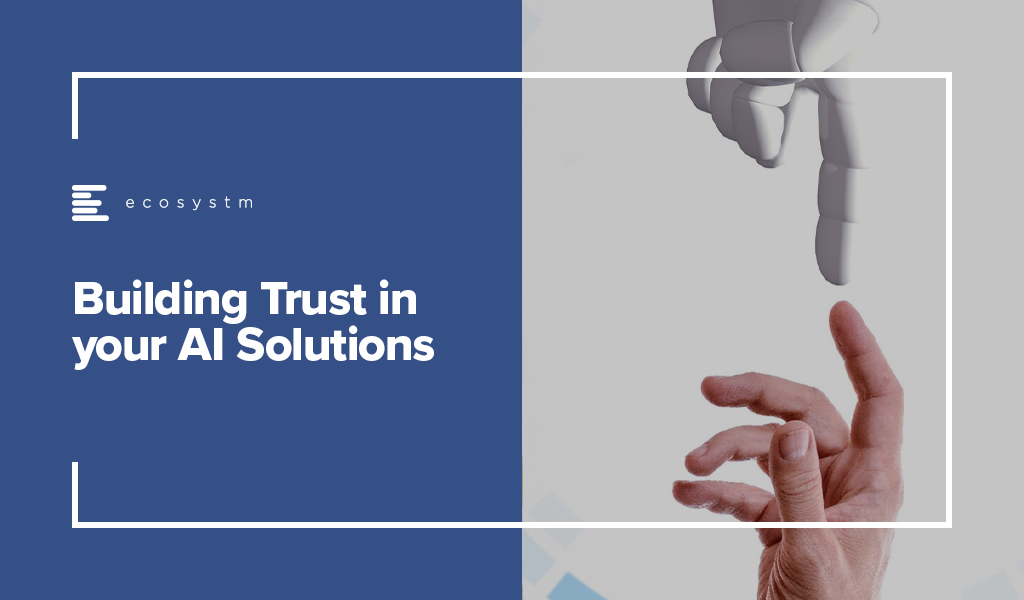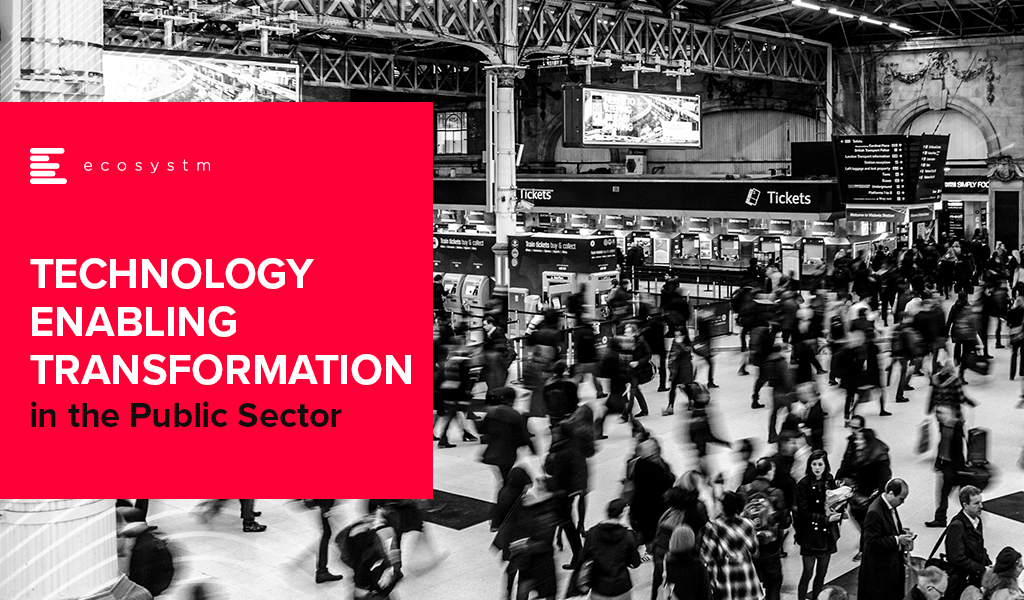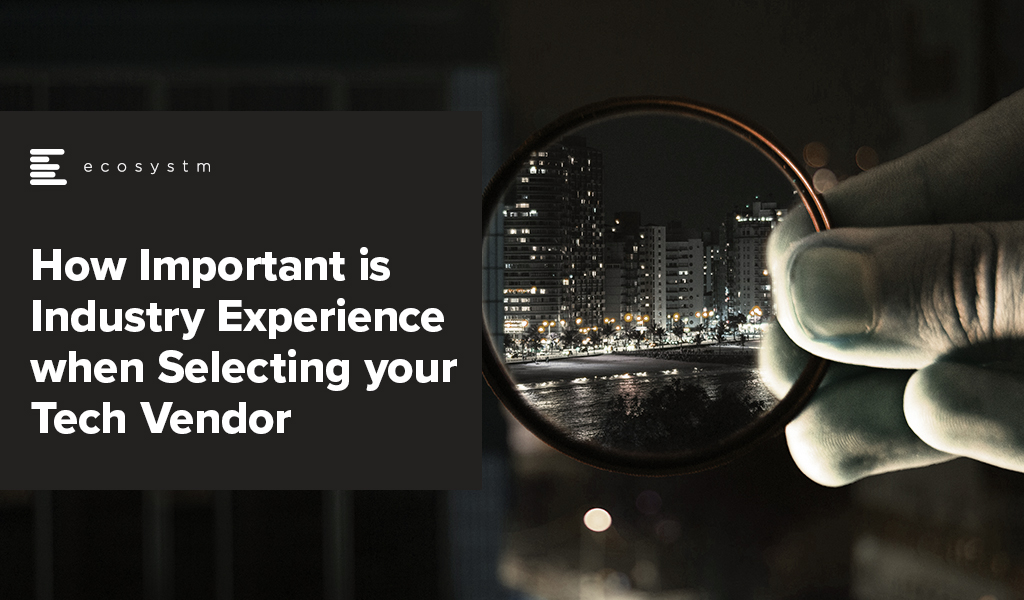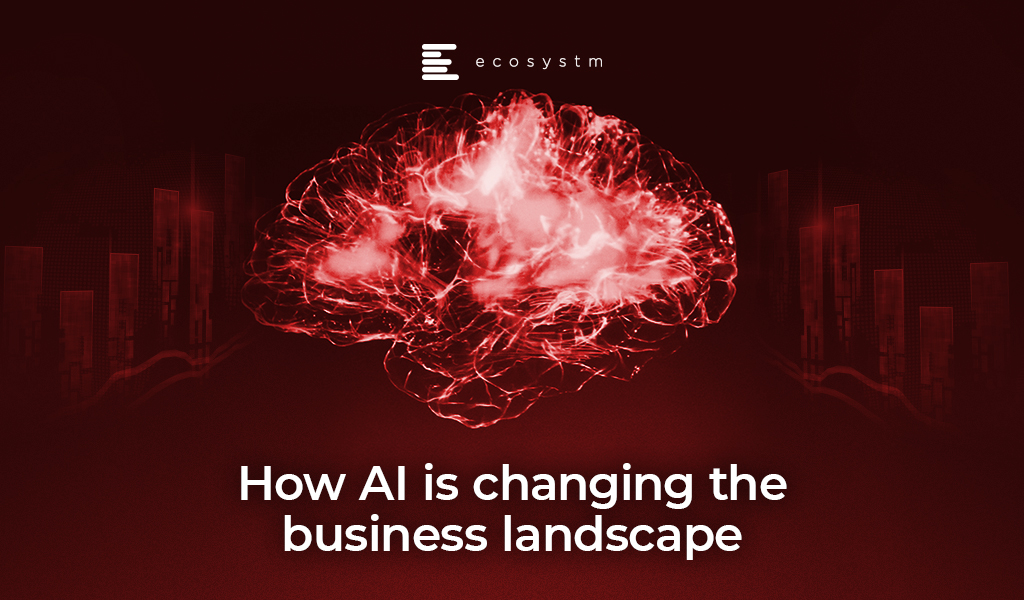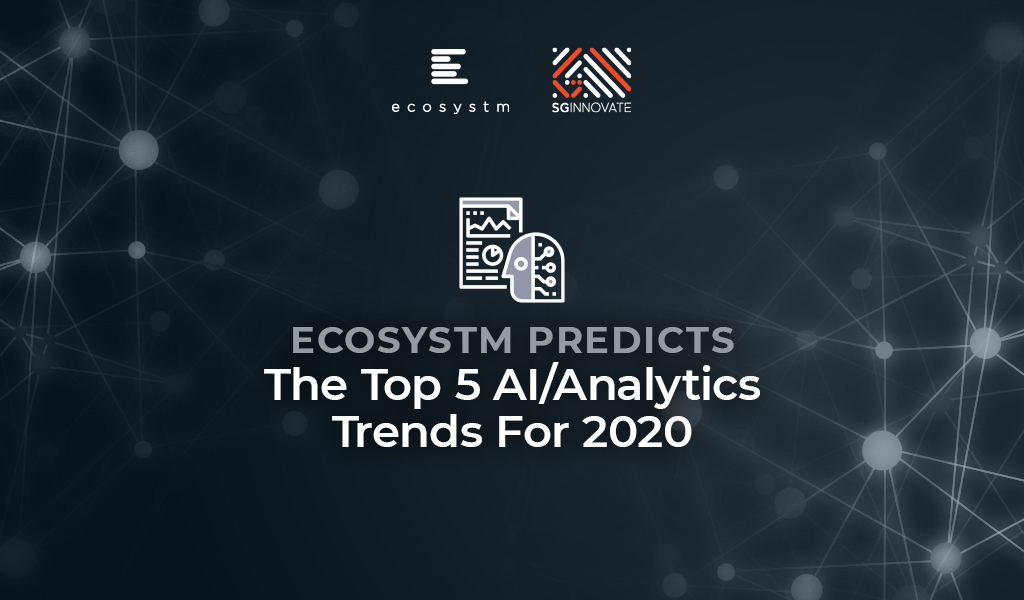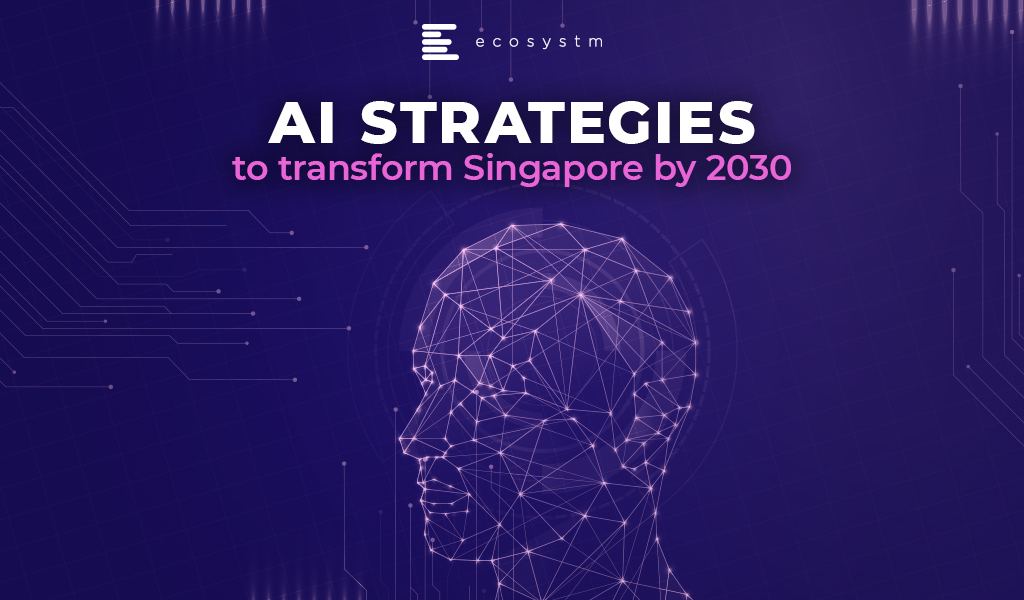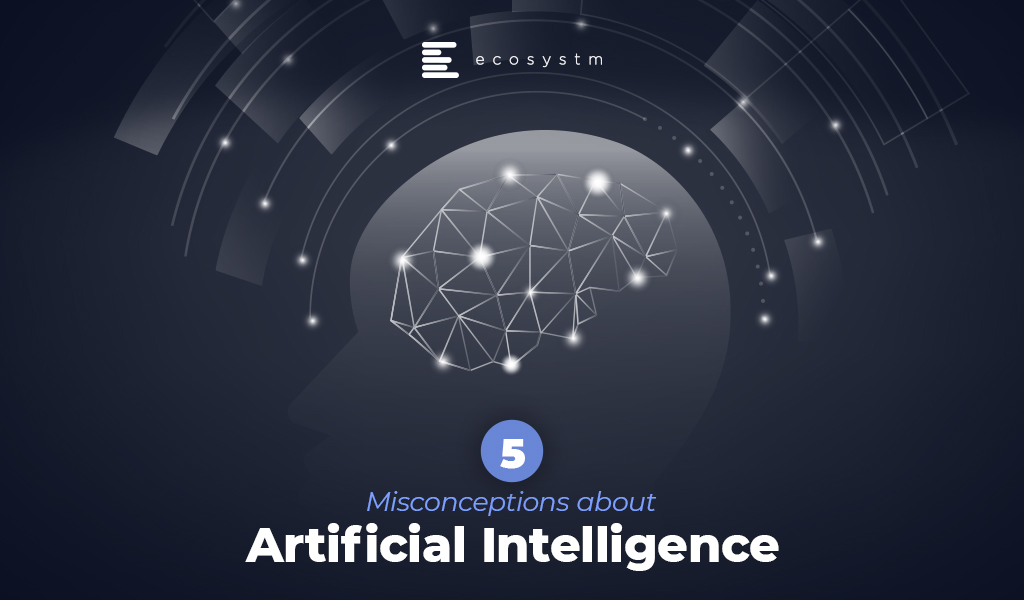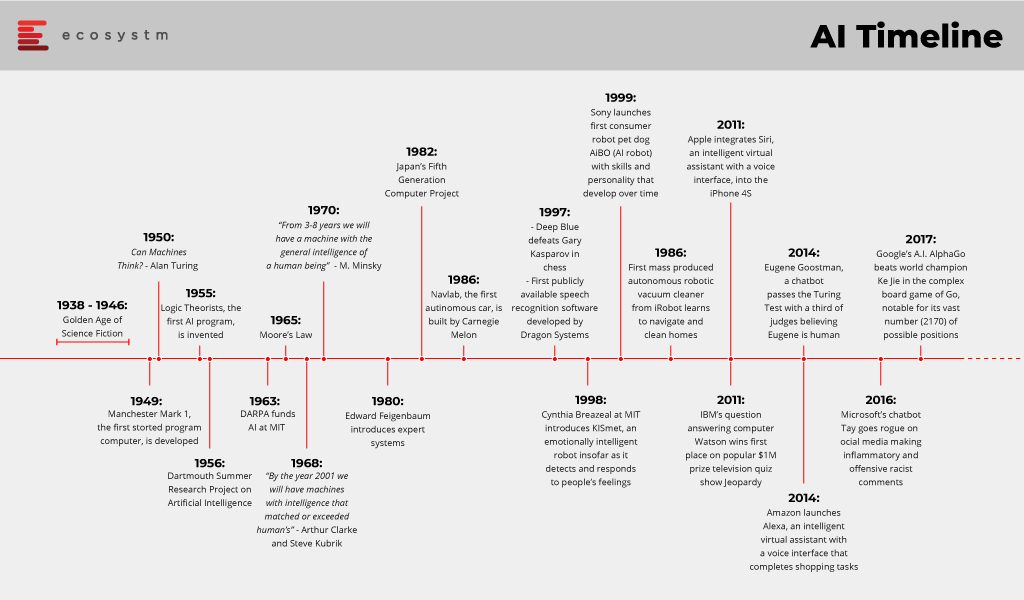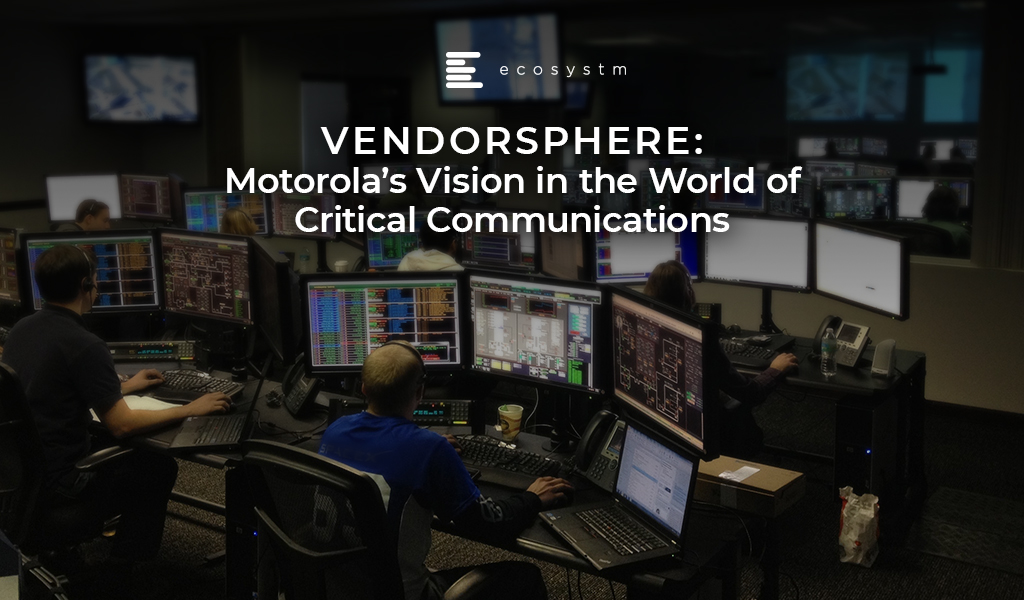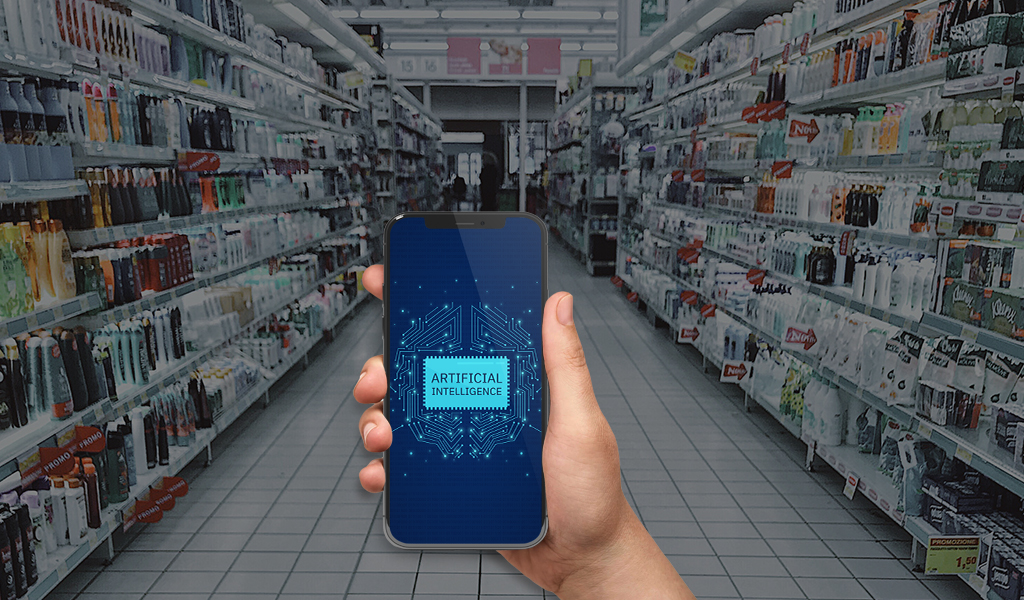In this blog, our guest author Shameek Kundu talks about the importance of making AI/ machine learning models reliable and safe. “Getting data and algorithms right has always been important, particularly in regulated industries such as banking, insurance, life sciences and healthcare. But the bar is much higher now: more data, from more sources, in more formats, feeding more algorithms, with higher stakes.”

Building trust in algorithms is essential. Not (just) because regulators want it, but because it is good for customers and business. The good news is that with the right approach and tooling, it is also achievable.
Getting data and algorithms right has always been important, particularly in regulated industries such as banking, insurance, life sciences and healthcare. But the bar is much higher now: more data, from more sources, in more formats, feeding more algorithms, with higher stakes. With the increased use of Artificial Intelligence/ Machine Learning (AI/ML), today’s algorithms are also more powerful and difficult to understand.
A false dichotomy
At this point in the conversation, I get one of two reactions. One is of distrust in AI/ML and a belief that it should have little role to play in regulated industries. Another is of nonchalance; after all, most of us feel comfortable using ‘black-boxes’ (e.g., airplanes, smartphones) in our daily lives without being able to explain how they work. Why hold AI/ML to special standards?
Both make valid points. But the skeptics miss out on the very real opportunity cost of not using AI/ML – whether it is living with historical biases in human decision-making or simply not being able to do things that are too complex for a human to do, at scale. For example, the use of alternative data and AI/ML has helped bring financial services to many who have never had access before.
On the other hand, cheerleaders for unfettered use of AI/ML might be overlooking the fact that a human being (often with a limited understanding of AI/ML) is always accountable for and/ or impacted by the algorithm. And fairly or otherwise, AI/ML models do elicit concerns around their opacity – among regulators, senior managers, customers and the broader society. In many situations, ensuring that the human can understand the basis of algorithmic decisions is a necessity, not a luxury.
A way forward
Reconciling these seemingly conflicting requirements is possible. But it requires serious commitment from business and data/ analytics leaders – not (just) because regulators demand it, but because it is good for their customers and their business, and the only way to start capturing the full value from AI/ML.
1. ‘Heart’, not just ‘Head’
It is relatively easy to get people excited about experimenting with AI/ML. But when it comes to actually trusting the model to make decisions for us, we humans are likely to put up our defences. Convincing a loan approver, insurance under-writer, medical doctor or front-line sales-person to trust an AI/ML model – over their own knowledge or intuition – is as much about the ‘heart’ as the ‘head’. Helping them understand, on their own terms, how the alternative is at least as good as their current way of doing things, is crucial.
2. A Broad Church
Even in industries/ organisations that recognise the importance of governing AI/ML, there is a tendency to define it narrowly. For example, in Financial Services, one might argue that “an ML model is just another model” and expect existing Model Risk teams to deal with any incremental risks from AI/ML.
There are two issues with this approach:
First, AI/ML models tend to require a greater focus on model quality (e.g., with respect to stability, overfitting and unjust bias) than their traditional alternatives. The pace at which such models are expected to be introduced and re-calibrated is also much higher, stretching traditional model risk management approaches.
Second, poorly designed AI/ML models create second order risks. While not unique to AI/ML, these risks become accentuated due to model complexity, greater dependence on (high-volume, often non-traditional) data and ubiquitous adoption. One example is poor customer experience (e.g., badly communicated decisions) and unfair treatment (e.g., unfair denial of service, discrimination, misselling, inappropriate investment recommendations). Another is around the stability, integrity and competitiveness of financial markets (e.g., unintended collusion with other market players). Obligations under data privacy, sovereignty and security requirements could also become more challenging.
The only way to respond holistically is to bring together a broad coalition – of data managers and scientists, technologists, specialists from risk, compliance, operations and cyber-security, and business leaders.
3. Automate, Automate, Automate
A key driver for the adoption and effectiveness of AI/ ML is scalability. The techniques used to manage traditional models are often inadequate in the face of more data-hungry, widely used and rapidly refreshed AI/ML models. Whether it is during the development and testing phase, formal assessment/ validation or ongoing post-production monitoring, it is impossible to govern AI/ML at scale using manual processes alone.
o, somewhat counter-intuitively, we need more automation if we are to build and sustain trust in AI/ML. As humans are accountable for the outcomes of AI/ ML models, we can only be ‘in charge’ if we have the tools to provide us reliable intelligence on them – before and after they go into production. As the recent experience with model performance during COVID-19 suggests, maintaining trust in AI/ML models is an ongoing task.
***
I have heard people say “AI is too important to be left to the experts”. Perhaps. But I am yet to come across an AI/ML practitioner who is not keenly aware of the importance of making their models reliable and safe. What I have noticed is that they often lack suitable tools – to support them in analysing and monitoring models, and to enable conversations to build trust with stakeholders. If AI is to be adopted at scale, that must change.
Shameek Kundu is Chief Strategy Officer and Head of Financial Services at TruEra Inc. TruEra helps enterprises analyse, improve and monitor quality of machine
Have you evaluated the tech areas on your AI requirements? Get access to AI insights and key industry trends from our AI research.

Governments face multiple challenges which are further getting highlighted by the ongoing global crisis. They have to manage the countries’ financial performances, reducing fiscal deficits. Every economy – whether emerging or mature – face challenges in bridging economic and social divides and ensuring equal access to infrastructure across the population. Most governments have challenges associated with the changes in demographics – whether because of rapid urbanisation, a fast ageing population or those associated with immigration policies.
Government agencies have the task of ensuring reliable public service, keeping their citizens safe, and striving for cost optimisation. In this constantly evolving world, agencies need to rely on technology to manage ever-growing citizen expectations and rising costs. Several government agencies have started their digital transformation (DX) journey replacing their legacy systems to transform the way they deliver services to their citizens.
Drivers of Transformation in Public Sector
Creating cross-agency synergies
Government agencies have access to enormous quantities of citizen data. But much of that data resides with individual agencies, often with no real synergies between them. For improved cost management and better utilisation of the data, it is imperative for governments to think of cross-agency collaboration systems and tools which give the larger entity a better visibility of their resources, contracts and citizen information. This involves, developing procedures, frameworks and working beyond their limited boundaries, leveraging technology to share information, applications, platform and processes. While this has been in discussion for nearly a decade now, most government agencies still work in departmental siloes and find it hard to work as a networked entity. The Ecosystm AI study finds that nearly three-quarters of public sector organisations find data access a challenge for their AI projects.
Improving citizen engagement
Increasingly, citizens are becoming tech-savvy and are expecting digital services from their government agencies. Not only that, but they are also ready to have conversations with agencies and provide feedback on matters of convenience and public safety. With the popularity of social media, citizens now have the capability to take their feedback to a wider open forum, if the agency fails to engage with them. Public sector organisations have to streamline and automate the services they provide, including payments, and provide real-time services that require collaborative feedback and increased participation from citizens. Smart governments are successfully able to leverage their citizen engagement to use open data platforms – Data.gov and data.gov.uk, are allowing communities to target and solve problems for which governments do not have the bandwidth. With citizen centricity and open government policies, there is also an ever-increasing need for greater accountability and transparency.
Managing project performance and costs
Most government projects involve several stakeholders and are complex in terms of the data, infrastructure and investments required. To take better decisions in terms of project complexity, risks and investments, public sector agencies need to have a structured project management framework, using an optimum mix of physical. technical, financial and human resources. In an environment where citizens expect more accountability and transparency, and where projects are often funded by citizens’ taxes, running these projects become even more complicated. Government agencies struggle to get funding, optimise costs (especially in projects that run over multiple years and political environments), and demonstrate some form of ROI. There is also an overwhelming requirement to detect and prevent frauds.
The global Ecosystm AI study reveals the top priorities for public sector, that are focused on adopting emerging technologies (Figure 1). It is very clear that the key areas of focus are cost optimisation (including fraud detection and project performance management) and having access to better data to provide improved citizen services (such as public safety and predicting citizen behaviour).
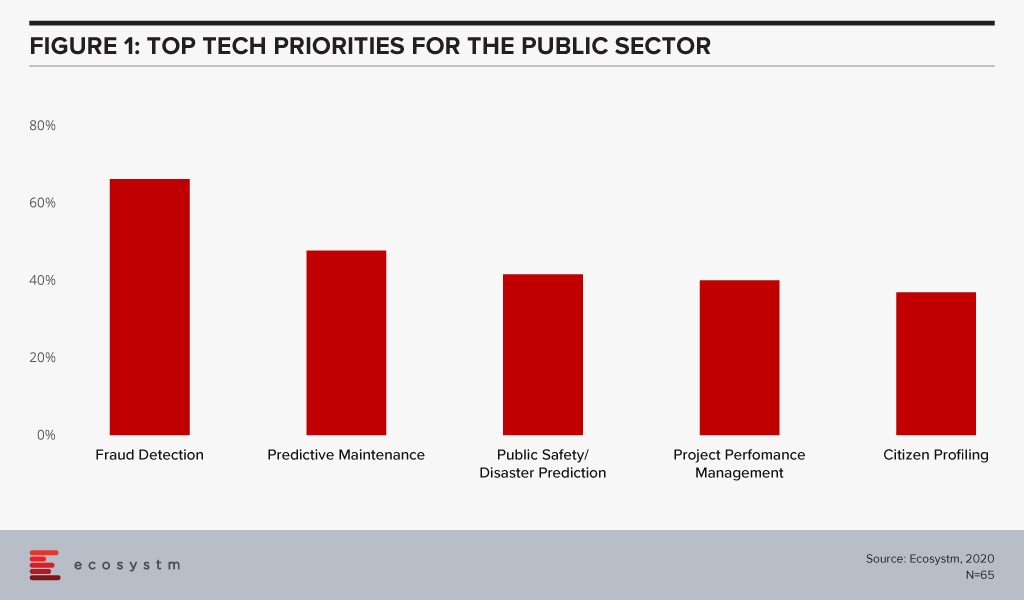
Technology as an Enabler of Public Sector transformation
Several emerging technologies are being used by government agencies as they look towards DX in the public sector.
The Push to Adopt Cloud
To prepare for the data surge that governments are facing and will continue to face, there is a push towards replacing legacy systems and obsolete infrastructure. The adoption of cloud services for data processing and storage is helping governments to provide efficient services, improve productivity, and reduce maintenance costs. Moreover, cloud infrastructure and services help governments provide open citizen services. The Government of India has built MeghRaj, India’s national cloud initiative to host government services and applications including local government services to promote eGovernance and better citizen services. The New Zealand Government has sent a clear directive to public sector organisations that public cloud services are preferred over traditional IT systems, in order to enhance customer experiences, streamline operations and create new delivery models. The objective is to use public cloud services for Blockchain, IoT, AI and data analytics.
Transparency through Communication & Collaboration technologies
Since the 1990s, the concept of eGovernment has required agencies to not only digitise citizen services but also work on how they communicate better with their citizens. While earlier modes of communication with citizens were restricted to print, radio or television, digital government initiatives have introduced more active communication using mobile applications, discussion forums, online feedback forms, eLearning, social media, and so on. Australia’s Just Ask Once allows citizens to access information on various government services at one place for better accessibility. More and more government agencies are implementing an omnichannel communication platform, which allows them to disseminate information across channels such as web, mobile apps, social media and so on. In the blog The Use of Technology in Singapore’s COVID-19 Response, Ecosystm analysts spoke about the daily updates shared by the Government through mobile phones. Demonstrating cross-agency collaboration, the information disseminated comes from multiple government agencies – the same channel is also used to drip-feed hygiene guidelines and the evolving government policies on travel, trade and so on.
AI & Automation for Process Efficiency and Actionable Intelligence
Governments are focusing on leveraging centralised resources and making processes smarter through the adoption of AI platforms. Initiatives such as the Singapore Government’s concept of Single Sources of Truth (SSOT), where all decision-making agencies have access to the same data, is the first step in efficient AI adoption. Singapore’s government agencies also have three data aggregators – Trusted Centers (TCs). This enables initiatives such as Vault-Gov.SG which allows government officials to browse a metadata catalogue and download sample data to run exploratory analytics. To push the adoption of AI, several governments are focusing on roadmaps and strategies such as Singapore’s National AI Strategies to transform the country by 2030, and the Government of Australia’s AI Roadmap and framework to help in the field of industry, science, energy, and education.
The first step of AI adoption is often through automation tools, such as virtual assistants and chatbots. The US Citizen and Immigration Service (USCIS) introduced an AI powered chatbot Emma to better support citizens through self-service options and reduce the workload of their customer service agents. The department of Human Services in Australia rolled out various chatbots named Roxy, Sam, Oliver, Charles and the most latest in progress PIPA (Platform Independent Personal Assistant) to provide information on various services and assist on queries.
Real-time data access with IoT
Governments have the responsibility of enforcing law and order, infrastructure management and disaster management. Real-time information data access is key to these initiatives. IoT sensors are being used in various government applications in object detection, and risk assessment in cities as well as remote areas. For example, IoT-enabled traffic monitoring and surveillance systems are embedded to provide real-time updates and continuous monitoring that can be used to solve issues, as well as provide real-time information to citizens. In a futuristic step, the US Department of Transportation (USDOT) is working with auto manufacturers on embedding vehicle to vehicle communication capabilities in all vehicles to avoid collision with emergency braking and vehicle speed monitoring. In an effort to promoting smart city initiatives and for infrastructure maintenance, New Zealand has installed smart cameras with automated processing capabilities, and IoT based street lighting system. IoT has tremendously benefited the supply chain and logistics sector. The US Army’s Logistics Support Activity (LOGSA) is using IoT for one of the Government’s biggest logistics systems. and military hardware with on-board sensors to analyse data directly from the vehicles for better asset maintenance. Again like in AI, there is a need for a clear roadmap for government adoption of emerging technologies, especially considering the safety and ethics angle. The Government of UK has introduced IoTUK, a program to help the public sector and private enterprises to come together and develop IoT technologies considering aspects such as privacy, security, and reliability.
Blockchain enabled Traceability & Transparency
Moving paper-based systems to digitised systems makes processes efficient to a degree. However, more is required for full traceability and transparency. Managing the data flow and safeguarding the information is vital for government organisations, especially as there is an increase in cross-agency collaboration. Government agencies and departments across the globe are increasingly collaborating using Blockchain technology, while at the same time maintaining the security of the data. For instance, in Georgia, the government department of Land, Property and Housing Management is using Blockchain to maintain land and property records. The blockchain-based land registry allows speedier approvals with no involvement of paperwork or multi-party signatures on physical documents. This is enhancing service quality while offering better security measures as the data is digitally stored in the National Agency of Public Registry’s land title database. Estonia is using Blockchain to protect their digital services such as electronic health records, legal records, police records, banking information, covering data and devices from attacks, misuse, and corruption.
Technology-led digital transformation has become the norm for public sector organisations across both emerging and mature economies. However, agencies need to create clear roadmaps and frameworks, including RoI considerations (which may not only be financial but should include citizen experience) and avoid ad-hoc implementations. The key consideration that government agencies should keep in mind is citizen security and ethics when adopting emerging technologies.

Identifying and selecting a vendor for your tech project can be a daunting task – especially when it comes to emerging technologies or when implementing a tech solution for the first time. Organisations look for a certain degree of alignment with their tech vendors – in terms of products and pricing, sure, but also in terms of demonstrable areas of expertise and culture. Several factors are involved in the selection process – vendors’ ability to deliver, to match expected quality standards, to offer the best pricing, to follow the terms of the contract and so on. They are also evaluated based on favourable reviews from the tech buyer community.
Often businesses in a particular industry tend to have their unique challenges; for example, the Financial Services industries have their specific set of compliance laws which might need to be built into their CRM systems. Over the years, vendors have built on their industry expertise and have industry teams that can advise organisations on how their business requirements can be met through technology adoption. These experts speak in the language of the industry and understand their business and technology pain points. They are able to customise their product and service offerings to the needs of the industry for a single client – which can then be repeated for other businesses in that industry. Vendors arm themselves with a portfolio of industry use cases, especially when they are entering a new market – and this often gives them an upper hand at the evaluation stage. In the end, organisations want less customisations to keep the complexity and costs down.
Do organisations evaluate vendors on industry experience?
Ecosystm research finds that industry experience can be a significant vendor selection criterion for some tech areas (Figure 1), especially in emerging technologies such as AI. AI and automation applications and algorithms are considered to be distinctive to each industry. While a vendor may have the right certifications and a team of skilled professionals, there is no substitute for experience. With that in mind, a vendor with experience in building machine learning models for the Telecommunications industry might not be perceived as the right fit for a Utilities industry implementation.
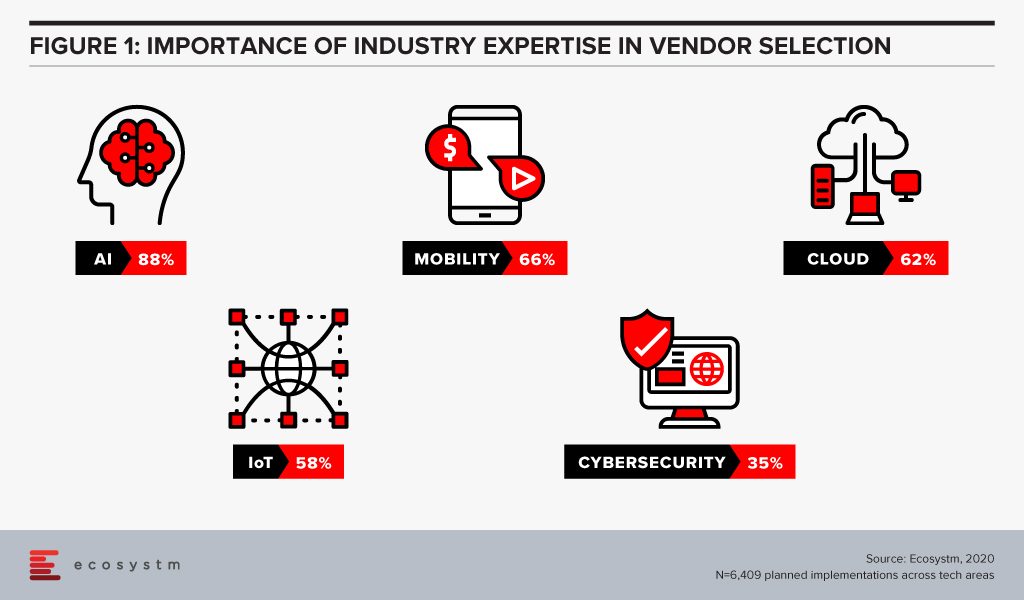
Whereas, we find that cybersecurity is at the other end of the spectrum, and organisations perceive that industry expertise is not required as network, applications and data protection requirements are not considered unique to any industry.
Is that necessarily the right approach?
Yes and no. If we look at the history of the ERP solution, as an example, we find that it was initially meant for and deeply entrenched in Manufacturing organisations. In fact, the precursor to modern-day ERP is the Manufacturing Resource Planning (MRP II) software of the 1980s. Now, we primarily look at ERP as a cross-industry solution. Every business has taken lessons on inventory and supply chain management from the Manufacturing industry and has an enterprise-wide system. However, there are industries such as Hospitality and Healthcare that have their niche vendors who bundle in ERP features with their industry-specific solutions. This will be the general pattern that all tech solutions will follow: a) an industry use case will become popular; b) other industries will try to incorporate that solution, and in the process; c) create their own industry-specific customisations. It is important, therefore, for those who are evaluating emerging technologies to cast their net wide to identify use cases from other industries.
AI and automation is one such tech area where organisations should look to leverage cross-industry expertise. They should ask their vendors about their implementations in other allied industries and, in some cases, in industries that are not allied.
For cybersecurity, their approach should be entirely different. As companies move on from network security to more specific areas such as data security and emerging areas such as GRC communication, it will be important to evaluate industry experience. Data protection and compliance laws are often specific to industries – for example, while customer-focused industries are mandated on how to handle customer data, the Banking, Insurance, Healthcare and Public Sector industries have the need to store more sensitive data than other industries. They should look at solutions that have in-built checks and balances in place, incorporating their GRC requirements.
So, the answer to whether organisations should look for industry expertise in their vendors is that they should for more mature tech areas. An eCommerce company should look for industry experience when choosing a web hosting partner, but should look for experience in other industries such as Banking, when they are looking to invest in virtual assistants.
Are some industries more focused on industry experience than others?
Ecosystm research also sought to find out which industries look for industry expertise more than others (Figure 2). Surprisingly, there are no clear differences across industries. The Services, Healthcare and Public Sector industries emphasise marginally more on industry expertise – but the differences are almost negligible.
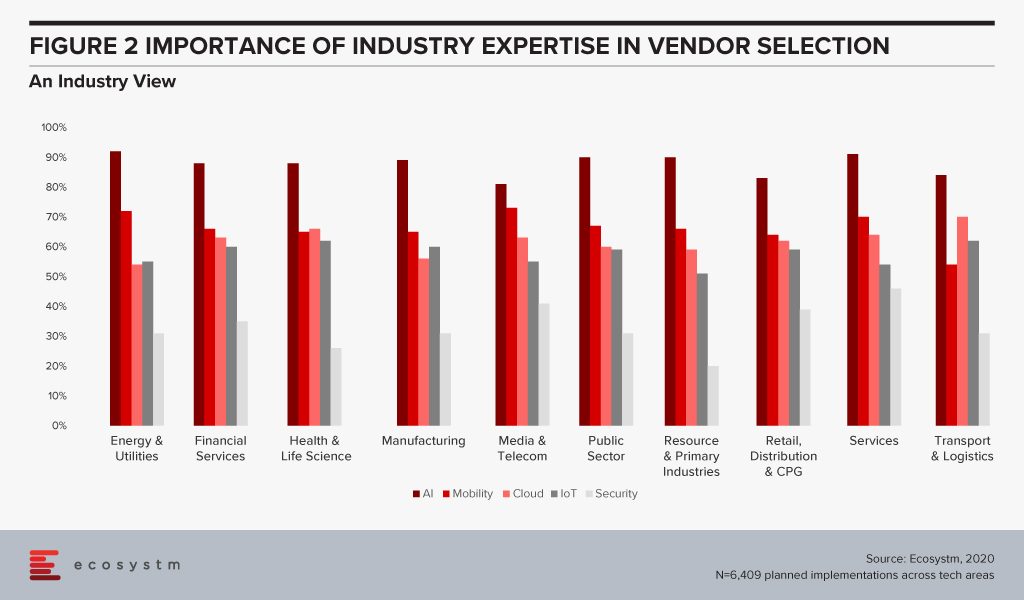
There are some differences when we look at specific tech areas, however. For example, industries that may be considered early adopters of IoT – Transportation, Manufacturing and Healthcare – tend to give more credit to industry experience because there are previous use cases that they can leverage. There are industries that are still formulating standards when it comes to IoT and they will be more open to evaluating vendors that have a successful solution for their requirement – irrespective of the industry.
The Healthcare Industry Example
Ecosystm Principal Analyst, Sash Mukherjee says, “In today’s fast-evolving technology market, it is important to go beyond use cases in only your industries and look for vendors that have a demonstrated history of innovation and experience in delivering measurable results, irrespective of the industry.” Mukherjee takes the example of the Healthcare industry. “No one vendor can provide the entire gamut of functionalities required for patient lifecycle management. In spite of recent trends of multi-capability vendors, hospitals need multiple vendors for the hospital information systems (HIS), ERP, HR systems, document management systems, auxiliary department systems and so on. For some areas such as electronic health records (EHR) systems, obviously industry expertise is paramount. However, if healthcare organisations continue to look for industry expertise and partner with the same vendors, they miss out on important learnings from other industries.”
Talking about industries that have influenced and will influence the Healthcare industry in the very near future, Mukherjee says, “Healthcare providers have learnt a lot from the Manufacturing industry – and several organisations have evaluated and implemented Lean Healthcare and Six Sigma to improve clinical outcomes. The industry has also learnt from the Retail and Hospitality industries on how to be customer focused. In the Top 5 Healthtech trends for 2020, I had pointed out the similarities between the Financial and Healthcare industries (stringent regulations, process-based legacy systems and so on). As the Healthcare industry focuses on value-based outcomes, governments introduce more regulations around accountability and transparency, and people expect the experience that they get out of their retail interactions, Healthtech start-ups will become as mainstream as Fintech start-ups.”
It is time for tech buyers to re-evaluate whether they are restricting themselves by looking at industry use cases, especially for emerging technologies. While less industry customisations mean easier deployments, it may also hamper innovation.
Artificial intelligence (AI) is perhaps the most electrifying and controversial of the so-called “disruptive” technologies. As AI becomes more sophisticated and the technology evolves, it will increasingly help to perform more complex tasks whether for personal or commercial use.
Today’s AI machines can replicate certain elements of intellectual ability and they are constantly striving to achieve more. This includes applications of autonomous vehicles, domestic and industrial robots, surveillance and security, automation, personal assistants, forecasting, data analysis and more.
The global Ecosystm AI study reveals top drivers of AI adoption. Organisations are trying to incorporate AI in their existing processes for better competitor analysis and insights, cost-effectiveness, deeper customer engagement to provide personalised service/product offerings, and for process redesign or automation.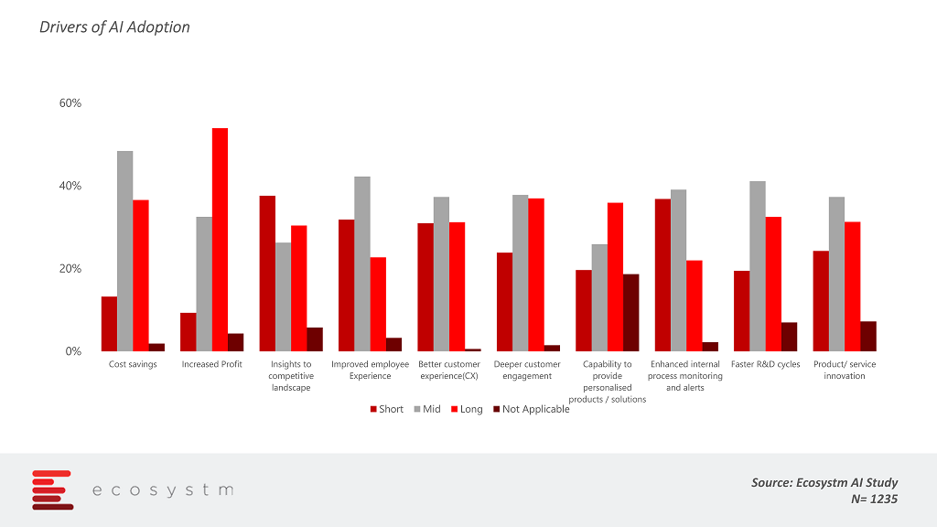
AI supporting technologies
AI is driving important technologies and processes and driving better, faster and more accurate decisions which help processes run more effectively and efficiently. With AI insights, business strategies will be more information-driven, efficient and consistent.
There are certainly many benefits that organisations are deriving from AI. Ecosystm AI study reveals that organisations implementing AI are using it to drive various business solutions including billing management, supply chain optimisation, predictive maintenance, enhancing operations and more.
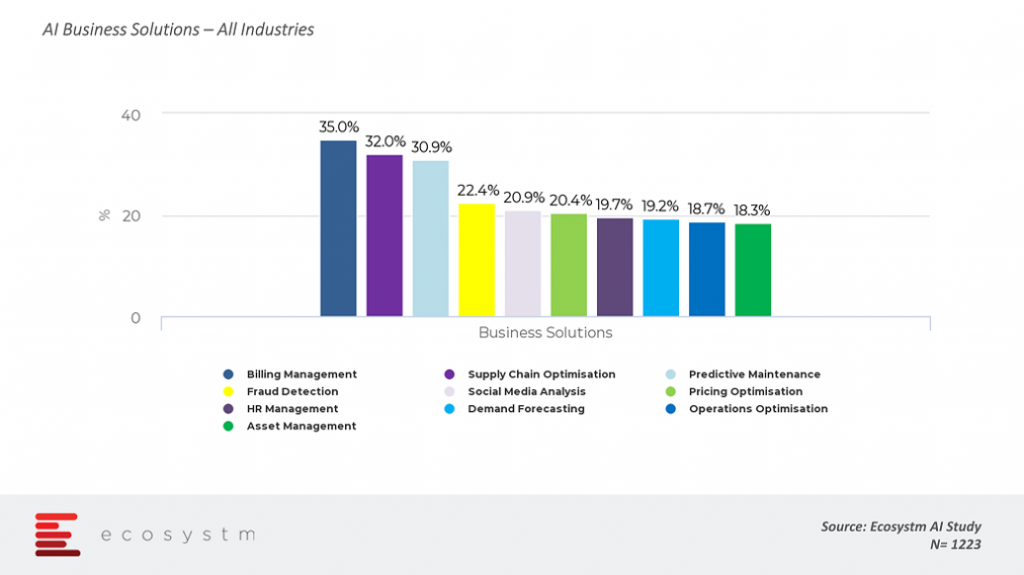
Below is a list of some hot technologies driven by AI.
Advanced Analytics
The proliferation of Big Data has led to the creation of massive data sets that can only be effectively analysed with AI tools and statistical models. AI can spot complex patterns in the data which is difficult for humans to understand. AI’s usefulness as an analytics tool is highly gaining importance in the use of predictive analytics and decision automation. Once sufficient data is available for use by AI, which is further filtered and processed thoroughly, the system can suggest actions or outcomes based on various parameters such as trends, patterns, historical information, frequency and more.
For example, the financial services industry is using advanced analytics to evaluate how customers earn, invest, spend and make financial decisions, which is useful for the organisations to customise their customers’ preference and offerings accordingly.
Natural Language Processing (NLP) and speech recognition
NLP involves the learning of languages by machine through the means of interaction between computers and unstructured speech/text. NLP requires massive processing power and complex algorithms to reinforce learning mechanisms. To help in NLP, AI generates models, which are further improved to create NLP and speech simulations. Nowadays, Natural language is being implemented and used in various conversational interfaces, such as those with bots, artificial learning agents that can generalise to new environments, and autonomous vehicles.
Cognitive processing
Otherwise known as semantic computing, refers to a digital processing that attempts to mimic the operation of the human brain. In general, semantics means the meaning and interpretation of words and sentence structure and how words relate to other words. So, how is semantic related and what is the semantic analysis used for in AI? Semantic technology processes the logical structure of sentences to identify the most relevant elements in the text to understand the topic. It is especially suited to the analysis of large unstructured datasets with high efficiency.
Vantagepoint has an artificial intelligence tool to improve their trading results. It has a patented tool which can forecast stocks, futures, commodities, Forex and ETFs and claims an accuracy of up to 86%. The tool can predict changes in market trend direction up to three days in advance thus enabling traders to get in and out of trades at optimal times with confidence.
Robotic Process Automation (RPA)
RPA has grown out of Business Process Automation (BPA) and refers to the use of AI to automate workflow and business processes. The advantages of RPA demonstrate it to be a solid tool in attaining higher quality output at lower costs which is much quicker than traditional methods. RPA can be used in IT support processes, back-office work, and workflow processes. The rules are programmed, and bots extract structured inputs from applications like Excel and enter them into other software such as CRM, SCM or accounting. A good example is the use of NLP to scan incoming emails and undertake the appropriate action, such as generating an invoice or flagging a complaint in an automated manner.
Machine Learning
Machine learning is an application of artificial intelligence (AI) which involves a combination of raw computing power and logic-based models to simulate the human learning process. Machine Learning is proving to be a successful approach to AI. When humans learn, they alter the way they relate information and the world, similarly when machines learn, they alter the data and form it into a piece of information.
An example, Image recognition is a popular application of machine learning in which images are fed into an algorithm, which attempts to recognise the contents of the image based on patterns. For instance, Yelp’s machine learning algorithms help the company’s human staff deal with tens of millions of photos to compile, categorise, and label the images more efficiently.
Chatbots and virtual assistants
Chatbots are robotic processes which simulate human conversation and automate functions. The technology is also used for so-called ‘virtual assistants’, which uses AI to interact with humans and aid with specific queries. They are increasingly being used to handle simple conversation and tasks in B2B and B2C environments. The addition of chatbots reduces human assistants and they can work throughout the clock. Chatbots and Virtual assistants improve with AI and can be trained to review conversations, past transactions and to draft a response based on context. If the user interacts with the bot through voice, then the chatbot requires a speech recognition engine.
Chatbots have been used in instant messaging (IM) applications and online interactive platforms. To exemplify, chatbots are deployed to assist online shoppers by answering noncomplex product questions, pricing, FAQ’s, order processing steps or forwarding information to human agents on complicated questions such as shipping delays or faults.
With AI technology evolving and improving so rapidly, many organisations are looking to use AI in their business, but there are still many questions to which adopters are seeking answers such as how to integrate AI into their existing systems, how to get access to data that will enable AI as well as the persistent technology concerns around cybersecurity and cost. The goal of many AI providers is to reach a stage where AI will support humans, control machines for us and automate repetitive tasks and processes.
Artificial Intelligence has come a long way and was one of the growing areas in 2019. Over the last few years, we have seen a growing number of AI based platforms, applications and tools that developers and scientists have worked to mimic a human brain. We believe that in 2020, AI will come out from the experimentation stage to the implementation and businesses will make deeper investments in AI to embed them in business applications.
This article presents the Top 5 Artificial Intelligence Trends for 2020 for the AI/Analytics market in 2020. It is based on the latest data from the global Ecosystm AI Study, and qualitative research by Ecosystm Principal Advisor Tim Sheedy.
The Top 5 Artificial Intelligence Trends for 2020
Here are the Top 5 Artificial Intelligence trends for 2020 that we believe will impact both businesses and consumers in 2020.
-
Digital Transformation puts Analytics Back on Top of the Tech Priority List
In an effort to help the business operate faster, IT teams are looking to better analytics to drive functions and decisions more accurately. While many business teams deploy their own technologies and systems – only the IT team is in a higher position to gather data from multiple systems of record in order to create the detailed insights that business users demand. Getting a view across the entire customer journey means analysing data across many systems – both front and back-end. Business teams struggle to get these types of insights on their own, which is why IT excels at providing great analytics to help make better and faster decisions.
Just like in previous generations of BI, the analytics market is starting to consolidate. While the ability to display data visually will always be important, it is the analytics that drives automated decisions that will often be of the most business value.
-
Automation will Lead Organisations to AI
RPA is increasingly moving beyond the usual task and process automation, to now being a business transformation lever. Additionally, there is an immense focus on incorporating AI/machine learning within RPA to make automation smart and intelligent. This allows software robots to mimic human behaviour and handle complex use cases, which was earlier not possible without human intervention.
Businesses will spend more money on their simple automation activities (RPA and analytics applications that do not learn) – but those that have already invested in automation are likely to want to take the next steps to AI.
-
AI will Start to be Embedded in Most Business Applications
To date AI has been an overlay to most applications – data is extracted from processes, learnings are made, and then the process is altered based on those learnings. In 2020 we will see mass availability of self-learning intelligent applications. The standard ERP, CRM, SCM, knowledge management solution and other business applications will have embedded intelligence. This will make it easier and faster for businesses to get the benefits of machine learning and AI without the need to hire expensive data scientists, or the requirement to learn the tools and platforms required for creating smart applications.
-
2020 will see the Democratisation of AI
Typically organisations required data scientists, AI coders, AI platforms and so on to do well in AI but with the increasing availability of AI in business applications, typical business users will begin to get a glimpse of what will be available at their fingertips in the next few years.
We expect templatised approaches to machine learning and associated technologies. Business users and data owners will be able to create algorithms that will improve business and customer outcomes. In some cases, we even expect AI to be available to consumers. We will start to see banking and finance applications that help better money management through learning – not just basic analytics, we will see more intelligent services in the market in 2020.
-
More Businesses Will Require AI on the Edge
In the next decade or two, it is estimated that there will be 100 billion IoT devices generating and exchanging data into the cloud, without any human intervention. With so many IoT devices generating a huge quantum of data, decisions will need to be made in real-time and the current cloud environments will be a bottleneck in data processing due to latency rates, network speed and traditional data architectures. To overcome this, Edge Computing solutions will be essential to work with a variety of sensor and data input devices, information processing and decisions driven by machine learning and AI, and additionally work with cloud for the next level of analytics, decisions and management.
Ecosystm in partnership with SGInnovate, the government-backed organisation that promotes Deep Tech in Singapore, released a series of four reports covering areas of mutual interest: Cybersecurity, Artificial Intelligence, Cities of the Future and Healthtech. ‘Ecosystm Predicts: The top 5 Artificial Intelligence trends for 2020’ report is a part of this collaboration and is available for download from Ecosystm and SGInnovate websites.
Download Report: The Top 5 Artificial Intelligence Trends for 2020
The full findings and implications of the report ‘Ecosystm Predicts: The Top 5 Artificial Intelligence Trends for 2020’ are available for download from the Ecosystm website. Signup for Free to download the report and gain insight into ‘the Top 5 Artificial Intelligence Trends for 2020’, implications for tech buyers, implications for tech vendors, insights, and more resources. Download Link Below ?

++Update: A few days after we added this story, Australia released its AI roadmap focused on future investment in AI and machine learning, and Artificial Intelligence: Australia’s Ethics Framework.
Over the last few years, many countries have created plans to harness Artificial Intelligence (AI) for better citizen services. At this week’s SFFXSWITCH (Singapore FinTech Festival and Singapore Week of Innovation and TeCHnology), Singapore announced the next step in its Smart Nation initiative with the release of the “National AI Strategy”. The AI strategy will focus on social and economic benefits by providing modern infrastructure, intelligent services, and an excellent education system to citizens.
Commenting on Singapore’s AI adoption and implementation strategies, Ecosystm Principal Advisor, Tim Sheedy said “being a smaller country, Singapore is one of the few around the globe that can make investments into AI at a ‘country level’. Singapore has the luxury of having a progressive public sector that operates at the same speed as the private sector, and has the opportunity to become one of the leading economies in the world for both the deployment of AI in everyday services AND in ensuring the economy has the required skills.”
The key approach of the AI strategy
Singapore is aiming to position itself as a global hub for the development and implementation of AI solutions. National AI Office established under the Smart Nation and Digital Government Office (SNDGO) will be heading Singapore’s AI initiatives.
To begin with, the SNDGO will be initially working on key high-value sectors:
- Transport and Logistics: Intelligent Freight Planning
- Smart Cities and Municipal Services: Infra management and smart services
- Healthcare: Chronic Disease Prediction and Management
- Education: Personalised Education
- Safety and Security: Seamless border clearance operations
Speaking on AI strategies devised for transportation, smart cities, healthcare, education and safety and security in Singapore, Sheedy said “all of these investments are ones that you would make as an economy if you had the opportunity. They are all logical and will all benefit the lives of citizens and the success of the overall economy.”
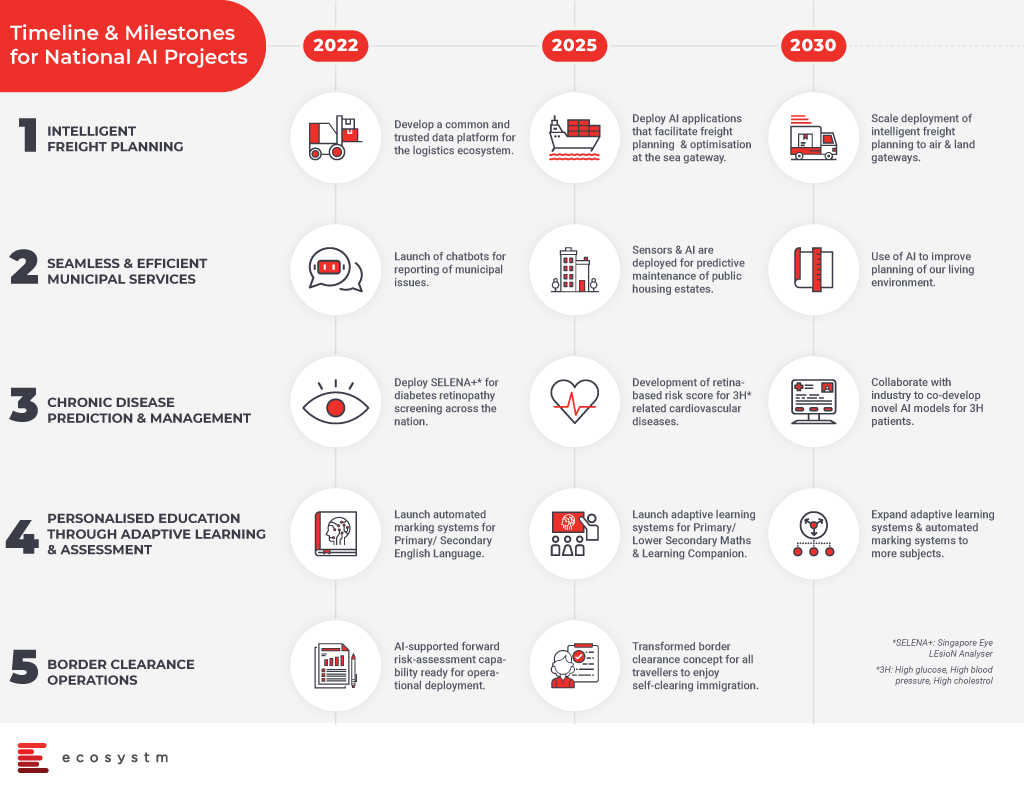
Transport and Logistics: To optimise the freight and delivery services, a common data platform will be built. The aim is to bring in efficient transportation and logistics with intelligent AI systems in place by 2022 and further AI developments will scale deployment, enable optimised delivery processes and routing of services for freight planning.
Smart Cities and Estates: The country aims to launch AI powered chatbots by 2022 to record municipal issues and allocate them to the responsible authorities. AI powered services will be introduced to better serve the residents. By 2025, efforts will be established to optimise estate maintenance through AI and sensors and by the year 2030, data driven insights will be used to improve the infrastructure and living environment in Singapore.
Healthcare: An all-new AI system known as SELENA+ will be in place to screen and detect diabetic eye disease. SELENA+ is a first artificial intelligence algorithm which performs automated retinal photo analysis to detect retinopathy and systemic complications in diabetics. In addition to this, AI capabilities will also be used to predict cardiovascular diseases and create personalised chronic risk scores. All of these will help to detect diseases and take early preventive measures by the healthcare teams for the welfare of country and betterment of the economy.
“This could detect chronic issues early, and reduce the impact of them on individuals, families and the economy. Being able to make investments at a macro level – like this happening in Singapore – will make sure everyone benefits” said Sheedy.
Education: AI in education will bring the benefits of automated marking systems for English language in primary and secondary education. Further, AI-enabled learning systems will help students on learning and mastery of topics. The government has planned to expand automated AI and adaptive learning systems to more subjects at a later stage.
Sheedy said, “with the government being able to influence and change the syllabus in schools and universities, as well as the skills in the public and private sector, Singapore is uniquely positioned to drive real economic benefit from their investment into AI.”
Safety and Security: AI systems will help in border security and clearance procedures. AI will enhance travel experience with automated immigration clearance systems involving face and iris scans. The immigration processes will develop into seamless self-clearance systems and become faster.
“A few countries have the ability to drive this level of planning – most countries have many levels of government which make this planning – or execution of plans – difficult.” said Sheedy. “Many are also leaving the investment to the private sector, which means it will happen eventually, but may see many competing initiatives or different capabilities emerge that only benefit a single company, not an entire economy.”
Smart Nation drive
Singapore’s government is highly active in transforming the country into a smart nation. Singapore was working with the World Economic Forum’s Centre for Fourth Industrial Revolution (WEF C4IR) in order to come out with a framework for ethical and responsible AI adoption and deployment by the Asian governments.
Singapore is also set to invest US$ 360 million on AI and other digital technologies through 2020 and has invited Chinese and American companies to be a part of this.
According to Sheedy, there are many benefits of having deep investments in AI and AI capabilities in an economy.
It will make Singapore a more attractive investment location. If access to government and other services are seamless, then the barriers to entry to starting a new business or creating a new business capability will be much lower. It will mean that it is easier to build a business case for businesses to move to Singapore or start in Singapore – attracting investment funds and employment into the island state.
It will boost export capabilities – both for the skills that will be in demand through technology and business service providers and for the intelligent products and services that will likely emerge from the early AI investments. If Singapore can make more of the products and services that they produce “smart” – then these products and services will see increased demand – both locally and outside of Singapore.
It will make Singapore a better place to live and visit. With seamless government services, easier travel into and out of the country, and a government that anticipates the needs of its citizens, the quality of life for residents will increase.
The country can get ahead of the challenges and downsides of AI – and legislate or plan for these challenges, to ensure these challenges are understood and managed before they become problems.
In the escalating initiatives to become an AI superpower, Singapore has clearly indicated they are fully committed to leveraging AI to drive growth and citizen services.
++Update
An AI roadmap report was published by the Australian Government in November 2019, co-developed by CSIRO’s Data61 and the Department of Industry, Innovation and Science. The report identifies the opportunities and benefits of AI that Australia could capture.
The report classifies the strategies to help develop AI capabilities to boost the productivity of industry, generate jobs, bring economic growth, and enhance the quality of citizens’ life. To drive this, Australia has identified 3 key areas where it has the best opportunity to create new value-
Health, Ageing, and Disability – To develop AI to improve healthcare, aged care, and disability services while reducing healthcare costs.
Cities, Towns, and Infrastructure – To develop an AI system for the cities and infrastructure to provide better services, safety efficiency in a smart and cost-effective way.
Natural resource and environment management – Develop AI for better natural resource management and improve the productivity of agriculture, mining, fisheries, forestry, and environmental management.

Innovation is often fuelled by the evolution of technology, which unlocks greater potential for businesses. Artificial Intelligence (AI) is often considered the trendiest of today’s emerging technologies, viewed as the real enabler of innovation. Many businesses are adopting AI and investing in AI-based solutions. However, every emerging technology faces the same stumbling block – trust. AI has been no different and despite the growing adoption, not everyone is ready to jump on the AI bandwagon yet.
The other major stumbling block for AI has been the inability of the common man to grasp the implications of the technology and differentiate it from what has been depicted in Science Fiction and dystopian novels. There is also confusion in the mind of technologists on the definition of AI. Some experts will say that only Deep Learning with non-linear algorithms is AI, while most vendors promote their automation tools like AI. A few misconceptions have hence arisen regarding AI, its uses and its impact on the workforce and society.
#1 AI is a new technology
Despite recent hype around the technology, AI is not a new technology and not a product of this century’s innovations. The beginnings of AI can be traced to the middle of the 20th century and then it gained pace. During the second world war, an English mathematician and computer scientist, Alan Turing documented his ideas on creating an intelligent machine. Turing’s test theory proposed that if a machine could engage in full conversation with no detectable variances from a human, the machine could be deemed as a thinking machine. Turing worked to crack the German military’s encryption, the ‘Enigma’ code.
Later in 1956, American computer scientist John McCarthy organised the Dartmouth Conference, where the term ‘Artificial Intelligence’ was first used.
Today, AI is a much broader term and refers to a range of technologies from Automation to Deep Learning.
#2 AI can replace the human brain – completely
Humans have evolved over millions of years from being hunter-gatherers to agricultural societies to a modern-day man who can succeed in secondary and tertiary industries. We have adapted, evolved and became good at surviving in the real world. Despite this many people hold an opinion that AI will replace the driving force of one of the most complex machines on this planet – the human brain.
AI has clearly come a long way. Its ability to learn vast amounts of data, recognise patterns, and produce results is improving us in countless ways. However, the problem with achieving true AI is also its greatest strength – that it does not learn like a human. The technology behind AI is scientific and complex and building a competitive AI from scratch requires expensive specialised talent. For instance, a successful image recognition solution is more accurate than most humans, but the same coding cannot address another type of problem.
AI cannot replace a complex structure of neurons and humans will continue to use their intelligence for more innovation. Humans do and will continue to, play a major role in most AI applications, especially critical ones in research and medicine. Each of our innovations has made the race more productive, and that is what AI will further add to the human race.
#3 AI poses a threat to security & privacy
While the benefits of AI and Big Data technologies are being felt, people also consider them as a threat to their anonymity and privacy.
With online social accounts, digital identities and other digital data gathering entities – both private and government – privacy has become a pertinent question. With the emergence of sophisticated AI systems, these privacy concerns have been aggravated. AI brings the ability to fetch, combine, and analyse a huge quantity of data from varied sources. The impression is that AI can perform these designated operations with no supervision and there is fear that humans will lose control of a system entirely. Instances of data and privacy breaches heighten this fear.
This fear may be unfounded. Today, AI systems can simplify user privacy policies on websites, which most of the users do not bother to read and simply click on the ‘Accept’ box. Polisis is an AI-powered automated analysis tool for privacy policies. Polisis pulls a website’s privacy policy and takes around 30 seconds to interpret it, display a summary, and present a flowchart of the policy with highlights on how the online service will handle user data. An AI-powered chatbot called PriBot, answers questions about the privacy policy of any company.
In reality, AI technologies are being utilised to create a safer and more secure society. AI brings speed, scale, and automation to computing and is changing the way we work, live, and interact. We are guiding AI capabilities for better healthcare provision, citizen safety, research accuracy, and even enhanced cybersecurity. Very often, the data used by these algorithms are aggregated and anonymised.
#4 AI will replace jobs
There is an abundance of fear, uncertainty, and doubts about the risk and opportunity of AI. Will it create jobs or destroy them?
There is no doubt that AI is poised to transform jobs and will change the face of employment. It is easier to see existing jobs disrupted by new technology than to envision what new jobs the technology will enable. AI is poised to replace tasks, not jobs. Some functions – and sometimes all the functions – of an individual or team might be automated. Employees with no plans or desire to re-skill should be concerned, but those who are continuously improving and changing their skill sets need not be too concerned that automation will put them in an unemployment queue.
“While businesses will face pain, as they adjust to new lower cost and higher productivity expectations – and employees will need to continually update their skills – the overall assessment is for jobs growth. It is just that the jobs created will be different to the jobs that exist today”, as Tim Sheedy (Principal Analyst, AI & Automation, Ecosystm) puts it in his report Automation Will Transform Jobs – Plan for Change Now
Read Report – https://www.ecosystm360.com/#/link?type=report&id=155b38c6-3764-4715-a9ad-1ec6447260ac
A few businesses today are creating Automation Teams or Centres of Excellence – banks, telecommunications providers and utilities are leading this push. With continued effort, AI will eventually become intelligent enough to understand the tasks and make them easier for the workforce. Employees need to trust, use and maximise the full potential of the technology, and see its benefits for scaled implementation.
The NAB Cloud Guild is a good example of how organisations should provide training to not just technology staff but to any interested employee, on emerging technologies to equip their business for future demands.
#5 AI is implemented only by large vendors
AI is driving many Digital Transformation (DX) projects and large vendors, especially with platform and enterprise capabilities, have had the first movers’ advantage in AI deployments. Businesses are striving to make their systems more intelligent for better process automation and customer retention. After 40 years of automating manual tasks using enterprise applications (such as ERP, SCM, and CRM), intelligent systems will make many of these systems redundant – or at the least reduce business reliance on them.
One of the big challenges for large businesses – and their IT teams – today is to customise their AI to their organisations’ DX requirements. Many companies have made their first foray into the world of AI – often starting with technologies such as RPA, IoT sensor analytics, and chatbots. They are now looking to go beyond evolving their RPA solutions into Smart Process Automation (SPA) solutions. They are also going beyond basic chatbots/ virtual assistants to implement NLG and semantic computing, as their customer focus deepens. For these large enterprises, integration of AI solutions with internal systems and other AI solutions is the key challenge, and they often prefer to partner with their existent enterprise vendor or systems integrator for their AI implementations.
However, smaller organisations and start-ups are equally leveraging AI. Several tech start-ups also exclusively focus on AI and are developing a niche, industry-specific solutions. These smaller solution providers will probably be integrated into larger vendors’ partner ecosystems, as their capabilities deepen, and their customer base grows. Organisations need not look to only larger, established vendors for their AI implementations.
AI is still an emerging technology and it might take some time for AI to be trusted. The truth, however, is that AI opens up immense possibilities for individuals, enterprises, and governments.
Do the supposed threats outweigh the benefits of AI? We would very much love to hear your suggestions, ideas, and thoughts on this subject.

Critical Communications World, 2019 – TCCA’s largest event in global public safety communication – was held in Kuala Lumpur in June. Mission-critical communications are essential to maintaining safety and security across a range from daily operations to extreme events including disaster recovery. A UN report estimated that economic losses from natural disasters could reach USD 160 billion annually by 2030.
I attended the event as a guest of Motorola Solutions – one of the leaders in this field. Many people associate Motorola only with phones not knowing that they have been the cornerstone of some of the largest critical communications deployments around the globe. For instance, Victoria Police completed its AUD 50M+ rollout of Motorola Solutions managed services, enabling almost 10,000 police officers across Victoria access to mobile devices loaded with smart apps, and data when and where they need it most.
Motorola’s ability to provide customers with a private network which is secure, robust and redundant in the event of disaster has also been one of the reasons for their success in the industry. In the event of natural disasters or terrorist attacks, situations can arise where networks will not be available to send and transport any information. Having a secure and private network is critical. That explains why some of the largest police departments in Asia work with Motorola and these include Singapore, Malaysia and Indonesia.x
Motorola acquired Australian mobile application developer Gridstone in 2016 and Avigilon, an advanced video surveillance and analytics provider in 2018. These acquisitions demonstrate how Motorola is innovating in the areas of software, video analytics and AI.
Key Takeaways:
Public Safety Moving to a Collaborative Platform with AI and Machine Learning
Andrew Sinclair, Global Software Chief for Motorola Solutions sees AI enhancing future command and control centres and allowing greater analytics of emergency calls. Call histories and transcriptions, the incident management stack, community engagement data and post incidence reporting are all important elements for command and control centres. Using AI to sieve through the information will empower the operator with the right data and to make the right on-the-spot decisions.
The Avigilon acquisition, enhances Motorola’s AI capabilities and less time is spent monitoring videos, giving first responders more time to do their jobs. The AI technology can make “sense” of the information by using natural language technology. For example, if asked to find a child in a red t-shirt, the cameras can detect the child and also create a fingerprint of the child. The solution enables faster incidence detection by using an edge computing platform. It gathers the information and processes it to relevant agencies making the search operation faster and more streamlined. The application of AI in the video monitoring space is still in its early days and the potential ahead for this technology is enormous.
The other area that can empower first responders better are voice activated devices. The popularity of Alexa and Echo in the consumer world will see greater innovation in the application of public safety solutions. For example, police officers responding to an emergency may have very little time to look at screens or attend to other applications that need touching or pressing of a button as time and attention is essential is such scenarios. The application of voice activated devices will be critical for easing the job of the police officer on the ground. This will not only save administrative work on activities such as transcription, but also help in creating better accounts of the actual happenings for potential court proceedings.
While it is still early days for a full-fledged AR deployment in public safety, there are potential use cases. For example, firemen standing outside a building to make sense of the surrounding area could use AR to send information back to the command and control centres.
The Growth of Cloud-driven Collaboration
Seng Heng Chuah, VP for Motorola APJ talked about the importance of all agencies in public safety to be more open and collaborative. For instance, currently most ambulance, police and fire departments work in silos and have their own apps and legacy systems. To achieve the Smart City or Safe City concept, collaborating and sharing information on one common platform will be key. He talked about the “Home Team” concept that the Singapore Government has achieved. Allowing all agencies to collaborate and share information will mean the ability to make faster decisions during a catastrophe. Making “sense” of the IoT, voice and video data will be important areas of innovation. Normally when a disaster happens, operators at command and control centres – as well as onsite staff – face elevated stress levels and accurate information can help alleviate that.
The move towards the public cloud is also becoming more relevant for agencies. In the past there was resistance and it was always about having the data on their own premises. In recent years more public safety agencies are embracing the cloud. When you have vast amounts of data from video, IoT devices and other data sources, it becomes expensive for public safety agencies to store the data on premise. Seng Heng talked about how public safety agencies are starting to “trust’’ the cloud more now. According to him, Microsoft has done a good job in working with local governments around the world, and their government clouds have many layers of certifications as well as a strong data centre footprint in countries. The collaboration between agencies and more importantly agencies embracing the cloud will drive greater efficiency in analysing, transcribing and storing the data.
The Rise of Outcome-based, Services-led Opportunities
Steve Crutchfield, VP of Motorola Solutions for ANZ, talked about how Motorola is a services-led business in the ANZ market. 45% of Motorola’s business in ANZ is comprised of managed services. The ANZ region is unique as it is seen as early adopters and innovators around public safety implementations. Organisations approach Motorola for the outcomes. Police and Ambulance for example in the state of Victoria use their services on a consumption model. Customers across Mining, Transportation, and Emergency Services want an end-to-end solution across the network, voice, video and analytics.
The need for a private and secure network is significant in several industries. In the mines, safety is of priority and as soon as the radio goes down it impacts productivity and when production stops that can results in huge losses for the mines. Hence the need for a reliable private network that is secure for the transportation of voice and video communication is critical.
Crutchfield talked about how the partner ecosystem is evolving with Motorola working with partners such as Telstra and Orion but increasingly looking for specialised line of business partners and data aggregation partners. Motorola works with 55 channel partners in the region.
Ecosystm Comment:
Motorola Solutions is an established player in providing an end-to-end solution in the critical communications segment. The company is innovating in the areas of software and services coupled with the application of AI. Dr Mahesh Saptharishi, CTO at Motorola Solutions talked about how AI will eventually evolve into “muscle memory”. That will mean that there is far greater “automatic’’ intelligence in helping the first responders make critical decisions when faced with a tough situation.
In the end the efficacy of critical communications solutions will not just be the technology stack, but the desire and ability for cross-agency collaboration. As public safety agencies analyse large volumes of data sets from the network right to the applications, they will have to embrace the cloud, and which will help them achieve scale and security when storing information in the cloud. From the discussions, it was clear that the public safety agencies have started acknowledging the need to do so and we can expect that shift to happen soon.
Motorola will need to keep evolving their channel partner model and start partnering with new providers that can help in delivering some of the end-to-end capabilities across Mobility, AI, software, analytics and IoT. Many of their traditional partners may not be able to be that provider as the company evolves into driving end-to-end intelligent data services for their clients. The company is playing in a unique space with very few competitors that can offer the breadth and depth of critical communications solutions.
Some of you may be familiar with the famous Goya painting, ‘Saturn Devouring His Son ‘, which belongs to his series of ‘Black Paintings’. It is the best comparison I can make after returning from the TechXLR8, IoT World Europe Summit in London.
In the painting we see the god Cronos/Saturn, who immutably governs the course of time, devouring one of his sons. I see Cronos as Artificial Intelligence (AI) and his son as the Internet of Things (IoT). The analogy can be carried further – there are other brothers waiting their turn to be devoured by this hungry father. Soon it will be Augmented Reality /Virtual Reality (AR/VR), Blockchain and Digital Twins.
If we look at the Ecosystm global IoT Study, we find that adopters of IoT are developing their capabilities in related technologies, with AI, Machine Learning and Predictive Analytics being the most significant. Very soon the IoT that is part of our lives will have AI embedded in them.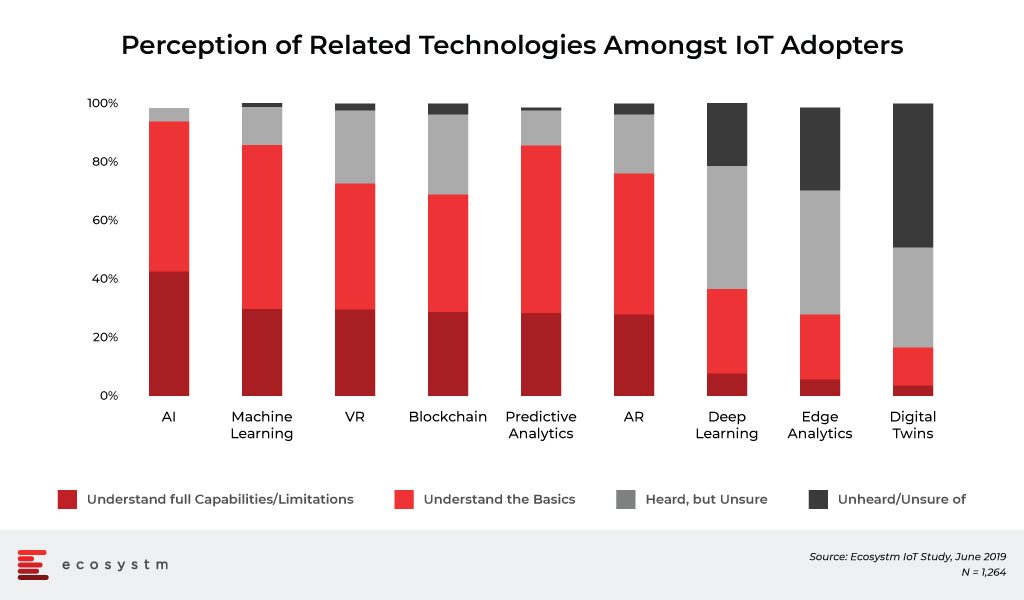
So, if you are still waiting for the IoT boom, this event is a confirmation that IoT is not throwing up many new things at least in Europe. The few IoT companies that exhibited their products and services at Excel London showed nothing that could overshadow the big winner, the ubiquitous father AI.
I have been finding it more difficult to justify coming to these IoT events. However, my role as a speaker and moderator allows me to maintain my influence and keep my followers on social networks, informed. The organisation this year has sought speakers that mix vendor presentations with success stories of clients. But this year neither of them was able to raise the tone of the event. The few large IT firms present such as Microsoft, SAP and Oracle are on the AI bandwagon and their demos on pure-play IoT are oft-repeated.
The larger systems integrators did not have adequate presence either. Many of them should have implemented IoT solutions for years but never really risked investing in IoT, and continue to focus on digitalisation projects, cloud migration projects, products updates and customised developments.
The discussions of the first years of the IoT boom revolved around connectivity, security, IoT platforms, and even business models. Now, nobody is interested in these matters anymore.
There was no significant IoT news during the event. Perhaps the most important announcement was made by Marc Overton who took advantage of his presentation to announce the recent collaboration agreement between Sierra Wireless and Microsoft to claim industry’s first full-stack IoT offerings.
As for my sessions, they mixed IoT and Blockchain, something that would have guaranteed success for attendees two years ago or even last year but that did not arouse great enthusiasm this year. It is evident that both technologies are becoming a commodity. Something that is not bad, since we would stop speculating about possible use cases and actually implement the technology in our lives and businesses.
Do not worry, the life of IoT events continues, and so this week there are three more just in Europe:
- Living bits and Things in Bled (Slovenia), during 17-18th June 2019
- IoT Tech Expo Europe in Amsterdam (Netherlands) during 19-20th June 2019
- IoT Week in Aarhus (Denmark) during 17-21st June 2019
Here is what I think event organisers and Tech vendors should keep in mind:
- Organisers need to find a way to facilitate meetings between vendors and attendants – and focus on how to create indirect lead generation opportunities. This would be mutually beneficial for all concerned.
- Organisers and exhibitors need to try to reinvent these IoT events where we see IoT present in every corner of the floor, in every stage, in every service (cafeteria, rest rooms, transportation….). We need to breath IoT every minute.
- IoT vendors need to demonstrate that they are working with partners and not present isolated use cases or demos. We need to see that “intelligent things” from different vendors in the exhibition area are interconnected.
Otherwise the IoT events will continue to drive away both visitors and exhibitors. What would you like to get out of future IoT events? Let me know.


